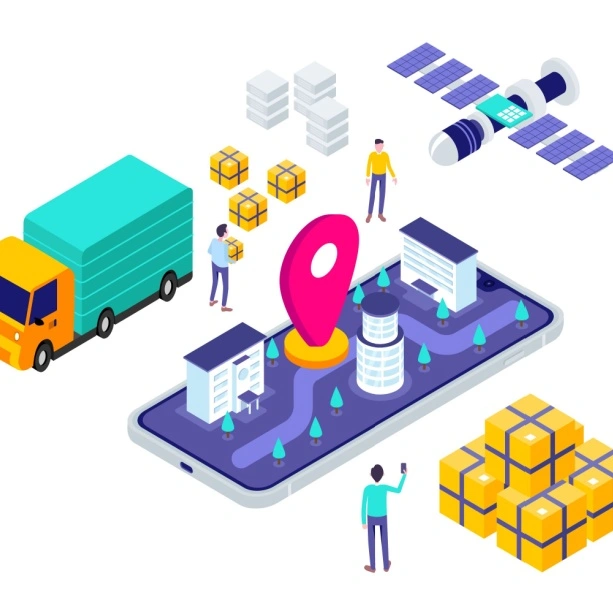Efficient management of assets is essential for staying competitive and driving growth within the industrial market. As operational managers navigate the complexities of asset tracking to this end, however, they are confronted with a critical decision: whether to invest in a customized asset tracking solution or opt for an off-the-shelf solution. This decision carries significant implications for the company’s operations, efficiency, and long-term success.
Increase Your ROI by Investing in AirFinder Everywhere
- Loss Prevention. Reduce the amount of loss that occurs during the supply chain process
- Location Coverage. AirFinder Everywhere uses a combination of GPS, Cellular, and WiFi to determine location everywhere
- Security Alerts. Know when a delay in shipment has occurred so the problem
can be addressed immediately.
Customized solutions offer unparalleled flexibility, allowing companies to tailor the system precisely to their unique needs and objectives. From customized workflows and reporting features to seamless integration with existing systems and technologies, customized solutions empower companies to optimize logistics processes, drive operational efficiency, and gain a competitive edge. On the other hand, off-the-shelf solutions provide simplicity and convenience, offering pre-packaged solutions that can be quickly deployed without the need for extensive customization. While off-the-shelf solutions may be suitable for companies with standardized processes and requirements, they may fall short in meeting the evolving needs and complexities of growing operations. Through a comprehensive exploration of customized and off-the-shelf asset tracking solutions, this blog aims to provide fleet managers with the insights and guidance needed to navigate the decision-making process effectively.
Why You Need An Asset Tracking Solution
An asset tracking solution is a vital component of modern logistics operations, offering an array of benefits that are indispensable for the efficient management of goods and resources. For instance, at the heart of logistics lies the need for precise inventory management, a task made significantly more manageable with the implementation of asset tracking technology. With an asset tracking solution in place, fleet managers gain real-time visibility into the movement and location of their assets, no matter where they are in the supply chain. This visibility streamlines processes, reduces manual errors, and optimizes resource allocation throughout the supply chain. Moreover, accurate tracking facilitates better planning and forecasting, helping to prevent stockouts or overstocking situations that can lead to unnecessary costs or delays. In an era where customer satisfaction is paramount, an asset tracking system also provides the means to deliver timely updates and notifications, enhancing transparency and improving the overall customer experience. Beyond customer service, asset tracking solutions also play a critical role in risk mitigation and compliance. By proactively monitoring assets, logistics companies can identify bottlenecks before they escalate, safeguarding both assets and reputation. Furthermore, the optimization of asset utilization afforded by tracking solutions allows for better decision-making regarding asset deployment and maintenance, ultimately leading to increased operational efficiency and cost savings. In essence, the necessity of an asset tracking solution in logistics operations cannot be overstated. From inventory management to risk mitigation, compliance, and customer satisfaction, these solutions serve as indispensable tools in navigating the complexities of modern supply chains, empowering companies to stay competitive in an ever-evolving business landscape.
What You Lack In An Off The Shelf Solution
Scalability Constraints
Off-the-shelf asset tracking solutions, while convenient for quick implementation, often come with scalability constraints that can pose significant challenges as companies continue to grow and evolve. One of the primary limitations lies in the predefined nature of these solutions, which may not easily accommodate the changing needs and complexities of expanding operations. As companies scale, they typically encounter an increase in asset volumes, diversified workflows, and evolving requirements, all of which may outgrow the capabilities of off-the-shelf solutions. These solutions often have predefined limits on the number of assets they can track or the level of data they can handle, leading to performance issues, data bottlenecks, and decreased system responsiveness. Moreover, off-the-shelf solutions may lack flexibility in terms of customization and configuration options, making it difficult to adapt the system to accommodate new logistics processes or integrate with emerging technologies. As a result, companies may find themselves constrained by the limitations of their off-the-shelf asset tracking solution, unable to scale efficiently or meet the demands of a growing operation. This scalability bottleneck not only hampers operational efficiency but also impedes innovation and competitiveness in a rapidly changing marketplace.
Integration Challenges
Integration challenges often accompany the adoption of off-the-shelf asset tracking solutions, posing obstacles to seamless connectivity and data exchange across various systems and platforms within an organization. Many companies have existing technology solutions that have the ability to be integrated with. Off-the-shelf solutions, however, often don’t have the same capability to integrate with other technology solutions. Additionally, ongoing updates to off-the-shelf solutions may introduce compatibility issues or disrupt existing integrations, requiring continuous monitoring and remediation efforts to ensure seamless operation. As a result, companies may find themselves grappling with fragmented data, inefficient workflows, and limited interoperability, undermining the effectiveness of their asset tracking initiatives. To address these integration challenges, organizations may be forced to invest in middleware solutions to bridge the gap between disparate systems and achieve a unified view of asset-related data across the enterprise, driving up cost and complexity.
Dependency on Vendor Roadmap
Dependency on the vendor roadmap is a significant concern associated with the adoption of off-the-shelf asset tracking software, as companies relinquish control over the direction and pace of software development and feature enhancements. Unlike custom-built solutions where businesses have a say in prioritizing specific features and updates, off-the-shelf solutions are governed by the vendor’s development schedule and product roadmap. This dependency can lead to frustrations and limitations, particularly when critical features or functionality desired by the business are not included in the vendor’s roadmap or are subject to lengthy development cycles. Companies may find themselves waiting for extended periods for essential updates or enhancements, hindering their ability to address emerging needs or respond to evolving industry trends in a timely manner. As a result, companies may feel constrained by the limitations of the off-the-shelf solution, unable to innovate or differentiate themselves effectively in the marketplace.
Tailored Reporting
The lack of tailored reporting capabilities is a common drawback of off-the-shelf asset tracking solutions, as these solutions often offer standardized reporting templates that may not fully align with the specific reporting needs and preferences of individual businesses. Off-the-shelf solutions typically provide a limited set of predefined reports, which may not capture all the KPIs or metrics relevant to a particular company’s operations and objectives. Consequently, fleet managers may find themselves unable to generate comprehensive insights or conduct in-depth analyses based on their unique requirements. Moreover, off-the-shelf solutions may lack flexibility in terms of report customization, making it challenging for them to modify existing reports or create new ones tailored to their specific needs. This lack of tailored reporting can impede decision-making processes, hinder performance monitoring, and limit the ability to identify trends, anomalies, or opportunities for improvement within logistics operations. Furthermore, off-the-shelf solutions may not offer advanced analytics capabilities or support for data visualization tools, further restricting the ability to derive meaningful insights from IT asset tracking software.
What You Gain From a Customized Solution
Scalability
Customized asset tracking solutions offer scalability advantages that empower companies to adapt and grow in tandem with their evolving needs and expanding operations. Unlike off-the-shelf solutions, which may have predefined limitations, customized solutions can be tailored to accommodate increasing asset volumes, diverse workflows, and changing requirements seamlessly. Through careful design and development, customized solutions can scale horizontally by adding new features, modules, or integrations as needed, ensuring that the system remains robust and responsive to the demands of a growing business. Furthermore, customized solutions provide flexibility in terms of architecture and infrastructure, allowing businesses to scale vertically by upgrading hardware, optimizing database performance, or leveraging cloud-based technologies to support larger datasets and higher transaction volumes. A customized asset tracking solution empowers organizations to maximize efficiency, minimize costs, and capitalize on growth opportunities, positioning them for long-term success in a dynamic and competitive marketplace.
Integration Flexibility
Customized asset tracking solutions offer seamless connectivity and interoperability with a wide range of existing systems and technologies within an organization. Unlike off-the-shelf solutions, which may have limited integration options or rely on proprietary protocols, customized solutions can be tailored to integrate with virtually any third-party software used in the business ecosystem. And if it can’t in the moment, it can be easily customized to do so. This capability is especially helpful to those using a telematics system. This way, data about your trailers and trucks can be collected and analyzed in one location for your ease.
Tailored Reporting
Customized asset tracking IoT solutions empower fleet managers to design and create reports that capture the exact metrics, KPIs, and insights relevant to their unique operations. This customization extends beyond basic reporting parameters to include advanced analytics capabilities such as predictive modeling, trend analysis, and outlier detection, enabling businesses to extract deeper insights from asset tracking data and make more informed decisions. By leveraging tailored reporting capabilities, fleet managers can gain a comprehensive understanding of asset utilization trends, operational efficiencies, and more, enabling them to streamline workflows and drive continuous improvement. These tailored reporting capabilities enable companies to foster collaboration, alignment, and data-driven decision-making throughout the organization.
Use Case Extensibility
If you’re investing in a commercial asset tracking system, you’re likely trying to solve a problem or improve your operations. You may even have multiple problems you’re trying to solve while simultaneously increasing efficiency. An off-the-shelf solution will have limitations in the use cases it can help you with, while a customized solution doesn’t have any. You can use the same customized solution to prevent loss while also increasing asset utilization and maintaining compliance. You don’t need three different off-the-shelf solutions to accomplish each goal when a customized solution can do all three at once. If, down the road, you have new problems you want to solve or different areas you want to improve, you still don’t need a new solution; you can build off of what you already are using.
Which Solution Should You Use?
AirFinder Everywhere stands out as the premier customizable asset tracking solution, offering unparalleled flexibility, scalability, and integration capabilities to meet the unique needs and challenges of businesses across industries. One of its key strengths lies in its robust customization features, allowing companies to tailor the solution precisely to their specific needs. Whether it’s configuring asset hierarchies, defining custom data fields, or designing personalized workflows, AirFinder Everywhere empowers businesses to create a bespoke asset tracking solution that aligns seamlessly with their operations. From implementation and onboarding to ongoing maintenance and optimization, the Link Labs team is committed to providing personalized support and guidance every step of the way. With its unmatched combination of customization, scalability, integration flexibility, and security, AirFinder Everywhere emerges as the best customizable asset tracking solution option for businesses looking to optimize their operations, enhance efficiency, and drive growth in today’s dynamic business environment.
Which Solution Will You Invest In?
The choice between a customized asset tracking solution and an off-the-shelf solution hinges on a multitude of factors, each carrying its own weight in the decision-making process. Customized solutions offer unparalleled flexibility, scalability, and integration capabilities, allowing businesses to tailor the system precisely to their unique needs and objectives. On the other hand, off-the-shelf solutions offer convenience and quick implementation, but may come with limitations in terms of customization, scalability, and integration flexibility. Ultimately, choosing a customized asset tracking solution is the best decision and will make your investment worth it. To learn more about our customizable solution, book a demo with us!

Publisher: Source link











